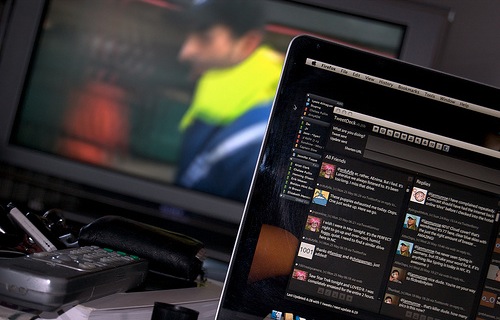The Art of Talking about Oneself on Television
Where television and internet advertising channels mix, you’ll find the best of the marketers weaving their magic. It’s a space where the usual rules cease to apply and the inexperienced social media moderator, AdWords controller or brand manager can find themselves a little lost.
I remember working with the IAB some years ago declaring to the world the headline that Internet advertising spend had overtaken television. Now in 2012, I find myself working with online brands which are becoming more and more reliant on and increasingly intelligent within the space of broadcast media.
Quite by coincidence, two of my clients (TheDogsDoodahs.com and Meningitis-Trust.org) planned to appear on television at roughly the same time this year. For both clients it would be the first large-scale broadcast of their online brand through TV, and for both the required measurable impact was digital.
One client paid (direct response style advertising in the lead up to a commercial ecommerce season), the other did not - instead featuring on a number of channels as a result of being especially newsworthy and relevant to planned programming.
Both brands prepared their activities well ahead of broadcast and also predicted that the exposure would teach them things about their marketing mix, public awareness, PR and digital mix that they wouldn’t be able to plan for. This is the first step in being smart when it comes to TV. We know that TV can make people feel things and we know it can make people do things - it becomes an obvious next conclusion that a lot of these feelings and actions will take place online.
Some events are easy to predict, such as an uplift in web enquiries moments after a broadcast. Others are harder to plan for or capitalise on, such as the equally strong uplift in web enquiries for your close competitors based on longtail searches triggered by a televised mention of your sector.
What is clear is that a vast number of people use a smartphone or browsing device simultaneously while they enjoy television. For some, the television fades into the background becoming the secondary activity. For a significantly large group, the two entertainment channels will combine. We only have to follow Twitter during national events such as the England match or anything at all related to the world of Simon Cowell to see evidence of that.
CPC advertising on affected keywords (not just your own brand) can swing the tide in your favour should economics allow. It's an expensive game that sees television broadcasting affecting and driving significant spikes in blogging, micro-blogging, fan activity and of course (on the largest scale) search engine activity. When you’re paying for the TV exposure, failing to also highlight your touchpoints in Google (whether they be your usual brand keywords or, as is much more likely a longertail including competing brands), will see your extra traffic lapped up by every website but your own.
Where a campaign isn’t planned as an advertisement as such, but rather a known news mention or an appropriated storyline in a popular programme, being on TV isn’t always a guaranteed path to an increase in hits. Richard Hudson at Meningitis Trust saw this for himself in the first of many slots his brand featured on in the first half of 2012:
"…we have found that being on TV doesn’t always make a measurable difference. For instance, after our Chief Executive was interviewed on a mainstream morning chat show there were absolutely no spikes in web traffic or calls to our helpline."
Now being on TV isn’t enough...
"So we’ve changed our attitude. Rather than patting ourselves on the back after the success of getting onto the TV, it’s now just the beginning for us. We’re no longer passive and expect people to be so amazed by what we do that they search us out to help. We’ve moved to being proactive and targeting the people who are dual screening – people who are watching TV and discussing the programme using Twitter or Facebook on their mobile phone or tablet..."
Richard goes further to suggest that Twitter gives a very “raw” version of someone’s emotive state:
"During any TV show, if you monitor comments on Twitter, you’re connected to someone’s inner thoughts. Very few people really edit their Tweets before sharing them with people. Tweets during a TV show are very much ‘this is how I feel, right now’.
During the week-long meningitis storyline on Hollyoaks, people were very open when sharing their thoughts and emotions:
"Oh no what's wrong with ash she just collapsed #Hollyoaks"
"i swear you only get meningitis when your a baby?! @Hollyoaks"
"Ash's condition hits close to home. Happened to my daddy #Hollyoaks."
"@MeningitisTrust I can't watch hollyoaks too close to home after my baby girls meningitis :("
This provides a perfect opportunity to reach out. In some ways you can answer questions and concerns even before Google has been typed into a browser and you’ve had to pay the PPC cost of securing that traffic."
Richard suggests the following tips for amplifying your brand through dual-screening:
- Keep your eyes on the TV schedules for opportunities
- Don’t expect every TV event to be a success - it depends on the time of day and audience. TV programmes being aired when people are sitting at home enjoying 'me time' works best for us
- Pre-plan different scenarios and prepare Tweets and content to push out
- Content should consist of pre-show build up, mid-show engagement and post-show feedback
- Most shows will have their own hash tag, track it using a tool like TweetDeck to see what people are talking about
- Conversations can be happening hours or even days afterwards, so plan this in with your team
- Release content and behind the scenes info during the two days afterwards for deeper engagement and education
- Think of where you’re going to send people to and what performance measures you want to put in place. The more learning you make, the better your performance will be next time
Both brands are aware that the immediate impact of a TV campaign might be only a small portion of the final measurable benefit. The impact on social media campaigns can be amplified into entirely new conversations that will continue in new groups of the populous for months or years.
The more accurately measurable journey from TV to search engine enquiry needs long term work too - both in PPC and SEO. Even if the first broadcast is free of charge (in the case of Meningitis Trust), the job of mopping up the resulting interest can be costly if not planned and accounted for beforehand.
As my brands move on through 2012, no doubt the lessons will continue to evolve into plans for the way they will work with broadcast media in the future. For now, it’s a fascinating journey. It’s an expensive one. It’s a stepping stone that most digital teams should consider, even if their first mention on Sky News is a little way off. It’s better to be prepared, than caught in the spotlight of television’s awesome glare.
Photo (cc) Ian Munroe



